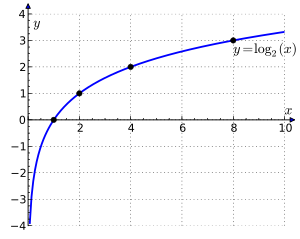Logarithms were introduced by John Napier in the early 17th century as a means to simplify calculations. They were rapidly adopted by navigators, scientists, engineers, and others to perform computations more easily, using slide rules and logarithm tables. Tedious multi-digit multiplication steps can be replaced by table look-ups and simpler addition because of the fact—important in its own right—that the logarithm of a product is the sum of the logarithms of the factors:
Logarithmic scales reduce wide-ranging quantities to smaller scopes. For example, the decibel is a logarithmic unit quantifying sound pressure and signal power ratios. In chemistry, pH is a logarithmic measure for the acidity of an aqueous solution. Logarithms are commonplace in scientific formulae, and in measurements of the complexity of algorithms and of geometric objects called fractals. They describe musical intervals, appear in formulae counting prime numbers, inform some models in psychophysics, and can aid in forensic accounting.
In the same way as the logarithm reverses exponentiation, the complex logarithm is the inverse function of the exponential function applied to complex numbers. The discrete logarithm is another variant; it has applications in public-key cryptography.
Contents
- 1 Motivation and definition
- 1.1 Exponentiation
- 1.2 Definition
- 1.3 Examples
- 2 Logarithmic identities
- 2.1 Product, quotient, power and root
- 2.2 Change of base
Motivation and definition The idea of logarithms is to reverse the operation of exponentiation, that is raising a number to a power. For example, the third power (or cube) of 2 is 8, because 8 is the product of three factors of 2:
Exponentiation
The third power of some number b is the product of three factors of b. More generally, raising b to the n-th power, where n is a natural number, is done by multiplying n factors of b. The n-th power of b is written bn, so that
Definition
The logarithm of a positive real number x with respect to base b, a positive real number not equal to 1[nb 1], is the exponent by which b must be raised to yield x. In other words, the logarithm of x to base b is the solution y to the equation[2]
Examples
For example, log2(16) = 4, since 24 = 2 ×2 × 2 × 2 = 16. Logarithms can also be negative:
Logarithmic identities
Main article: List of logarithmic identitiesSeveral important formulas, sometimes called logarithmic identities or log laws, relate logarithms to one another.[3]
Product, quotient, power and root
The logarithm of a product is the sum of the logarithms of the numbers being multiplied; the logarithm of the ratio of two numbers is the difference of the logarithms. The logarithm of the p-th power of a number is p times the logarithm of the number itself; the logarithm of a p-th root is the logarithm of the number divided by p. The following table lists these identities with examples. Each of the identities can be derived after substitution of the logarithm definitions x = blogb(x), and/or y = blogb(y), in the left hand sides.
Formula Example product 

quotient 

power 

root ![\log_b \sqrt[p]{x} = \frac {\log_b (x)} p \,](http://upload.wikimedia.org/math/3/c/a/3ca49ea6d6cf9ced59d76f8fc5e42755.png)

Change of base
The logarithm logb(x) can be computed from the logarithms of x and b with respect to an arbitrary base k using the following formula:










